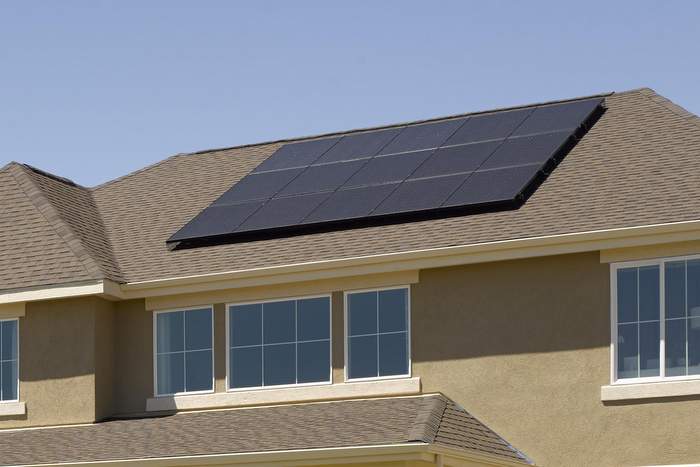The technology and techniques for mounting solar panels on roofs has been around for a surprisingly long time (as early as 1884). Thanks to that history and the improvement of techniques over time, rack-mounted solar panels present the lowest financial barrier to homeowners considering solar.
There are, however, many things to take into the consideration before recommending a rack-mounted solar system to a client. Unlike solar roofing that sits directly on top of the decking and functions like shingles, rack-mounted solar systems require penetrations through the existing roofing system and into the rafters that can expose the roof to water damage if certain precautions aren’t taken. The roof system must also be able to accommodate the weight of the rack and solar panels.
Here are some ways to spot potential issues before installing a rack-mounted solar system and best practices to ensure that the roofing system isn’t compromised.
The Roof System
The first thing you need to assess is whether the roof is sturdy enough to support a rack-mounted solar system. Depending on their size, solar panels can weigh around 40 pounds (about 2.28 pounds per square foot) each and average solar panel installations may include as many as 20-30 solar panels.
A well-built, modern roofing system will include a roof truss, wood frame, decking, insulation, ventilation (soffits or a ridge vent), waterproof underlayment, and proper shingles or tiles. If any one of those items are damaged or missing, it will create a weak base for rack-mounted solar. Flashing for penetrations and drip edge for eaves and rakes will also need to be added, since those areas are where most leaks occur.
The homeowner you’re working with may not know the history or age of their roof system, so you’ll want to look out for warning signs that significant roof repair or replacement is necessary:
- Age-related damage: If you notice excessive roofing granules in the gutters, loose nail heads, bare shingles (individual shingles completely stripped of their protective coating), or broken/brittle shingles, it’s probably time for a new roof before a new solar system.
- Punctures or cracks in the roof: These can occur over time from things like fallen tree branches, hail damage, even animals like squirrels and woodpeckers. Light foot traffic as a part of maintenance can cause cracks or punctures if the roof system is weak in certain places.
- Standing water/water damage: A roof that is properly sloped and sufficiently flashed should be able to effectively move water away from its surface. Any puddling is a sign of a trouble. Water intrusion on the roof surface can lead to deterioration that extends into the rafters. Water damage is the single greatest threat to a roof, so you’ll want to do a thorough examination above and under the roof to rule it out.
- Damage to the roof structure: While water can do significant damage to the structural integrity of a roof, supports can occasionally shift due to tectonic forces, seismic activity, or foundational issues. Warped decking or sagging areas of a roof are signs of a weak support structure.
Proper Flashing is Key
Once you’ve determined that the roof system is safe for a rack-mounted solar system, the next thing you’ll want to worry about is flashing. Flashing is perhaps the most time-consuming aspect of a solar installation and the most common area where installation errors are made.
You need to be extremely intentional about keeping water away from any holes that are made in the roofing system to attach the mounting system for the solar panels. Here are some best practices to keep your flashings secure and the roof system watertight:
Carefully locate the rafters: Rafters may not always be completely straight, so the rafter location may vary as it travels from ridge to eave. Techniques like tapping a rubber mallet and mapping of the rafters can help you locate the best place to secure your lag bolt, but using a good stud finder if the fastest and most accurate method. Be sure to center the lag bolt in the middle-third of the rafter to ensure structural integrity after the panels are installed.
Drill a pilot hole and backfill with sealant: Drilling a pilot hole not only ensures that the lag bolt won’t split the rafter, but also allows you to ensure that the lag will be located within the rafter. If your initial pilot hole doesn’t fully engage the rafter, reassess and drill another pilot hole. Make sure to backfill any errant holes with sealant.
Carefully pry up the shingles where the flashing is to be installed: Older shingles are more brittle than newer shingles, cold shingles are more brittle than warmer shingles, and some shingle sealants are very strong. Work carefully and slowly when prying up shingles so that they don’t tear.
Remove shingle nails that interfere with flashing: If you don’t remove the nails, you won’t be able to get the flashing far enough up to cover that butt joint. It’s necessary to either remove the nails or cut a “V” notch in the flashing where the nails are. If the nails are removed, you need to backfill the nail holes with roofing grade sealant to avoid leaks later on.
Seal the shingles back down to the flashing: Applying a quarter-sized dab of roofing grade sealant will help ensure that shingles stick to the flashing. This will reduce the likelihood of a shingle blowing off in a wind event.
Rack-mounted solar systems offer homeowners the lowest bar of entry in terms of adopting solar. Addressing roof damage on the front end and ensuring proper flashing are the best ways to set expectations and ensure customer satisfaction down the road.
Chris Fisher, Solar Business Development and Marketing Manager at CertainTeed.
— Solar Builder magazine
[source: https://solarbuildermag.com/news/roof-assessment-checklist-for-rack-mounted-solar-installs/]

 , SunModo’s newest solar mounting innovation. Learn more here.
, SunModo’s newest solar mounting innovation. Learn more here.
Leave a Reply
You must be logged in to post a comment.